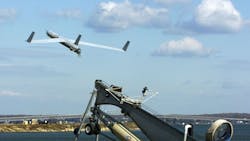Navy orders 179 small surveillance and reconnaissance UAVs from Boeing Insitu with multisensor payloads
PATUXENT RIVER NAS, Md. – U.S. Navy unmanned aircraft experts are buying as many as 179 small reconnaissance unmanned aerial vehicles (UAVs) for the U.S. Navy, U.S. Marine Corps, and foreign militaries under terms of a $390.4 million contract announced Friday.
Officials of the Naval Air Systems Command at Patuxent River Naval Air Station, Md., are asking Boeing Insitu Inc. in Bingen, Wash., to provide as many as 86 86 RQ-21A Blackjack UAVs and as many as 93 ScanEagle UAVs for the Navy, Marine Corps, and foreign allies.
The Boeing Insitu Blackjack UAV is eight feet long with a 16-foot wingspan. It weighs 81 pounds, and is designed to carry multisensor payloads in a large pod below its nose. The UAV can fly as fast as 104 miles per hour, cruises at 63 miles per hour, can fly as long as 24 hours, and can fly as high as 19,500 feet. It is a version of the Insitu Integrator UAV.
The Boeing Insitu ScanEagle UAV is 5.1 feet long with a 5.6-foot wingspan. It weighs as much as 48.5 pounds and can carry a 7.5-pound sensor payload. The UAV can fly for more than 24 hours at altitudes as high as 19.500 feet, and at speeds to 80 knots.
Related: Sensor payloads for unmanned vehicles
In addition to the Navy and Marine Corps, these UAVs are for the governments of Canada, Poland, and Oman. The contract includes training, test, support, maintenance, hardware installs, and repairs.
The RQ-21 Blackjack is a twin-boom, single-engine, monoplane UAV for surveillance and reconnaissance. Users can launch and recover the reconnaissance drone on land or at sea without runways by using a pneumatic launcher and net-type recovery system.
Users can customize the RQ-21A Blackjack's multi-mission open-architecture payload bays with visible-light and infrared cameras, communications, and other tools to provide situational awareness information to warfighters on the forward edge of battle.
The drone can integrate new payloads quickly, offers roll-on, roll-off capability to move the system quickly from ship to shore, as well as to and from cargo aircraft. The UAV can carry sensor payloads as heavy as 39 pounds.
Related: Navy orders six RQ-21A UAV reconnaissance drones from Boeing Insitu in $70.1 million deal
The Blackjack's standard sensor payload consists of a visible-light imager, mid-wave infrared imager, laser rangefinder, infrared marker, communications, and automatic identification system.
The RQ-21A provides persistent maritime and land-based tactical reconnaissance, surveillance, and target acquisition (RSTA) data collection and dissemination capabilities.
For the Marine Corps it will provide the expeditionary force, divisions, and regiments with a dedicated intelligence, surveillance, and reconnaissance (ISR) system that sends information to the tactical commander in real time.
For the Navy the Blackjack will provide persistent RSTA information to Navy ships, Marine Corps land forces, Navy expeditionary combat command forces, and Navy special warfare units.
Related: Special Operations Command chooses Textron and Insitu for UAV surveillance
The ScanEagle UAV, meanwhile, can fly on gasoline or heavy fuels like jet fuel, diesel, or kerosine. It provides persistent surveillance and reconnaissance imagery on land or at sea at lower costs than other surveillance methods for military and agriculture missions.
ScanEagle can carry a sensor payload consisting of visible-light camera, medium-wave infrared imager, or both integrated in one turret. The UAV ans has an analog digitally encrypted video data link, as well as encrypted or unencrypted command-and-control data link.
The UAV can be launched autonomously and uses a no-nets recovery system that recovers with its wing tip on a rope that hangs from a boom.
On this contract Insitu will do the work in Bingen, Wash., and at other locations inside and outside the continental U.S., and should be finished by June 2022. For more information contact Boeing Insitu online at www.insitu.com, or Naval Air Systems Command at www.navair.navy.mil.

John Keller | Editor-in-Chief
John Keller is the Editor-in-Chief, Military & Aerospace Electronics Magazine--provides extensive coverage and analysis of enabling electronics and optoelectronic technologies in military, space and commercial aviation applications. John has been a member of the Military & Aerospace Electronics staff since 1989 and chief editor since 1995.

